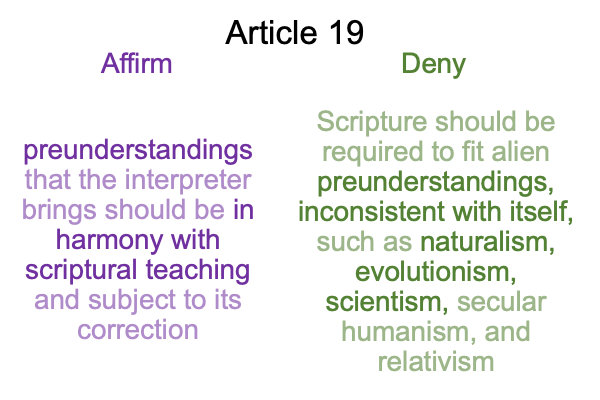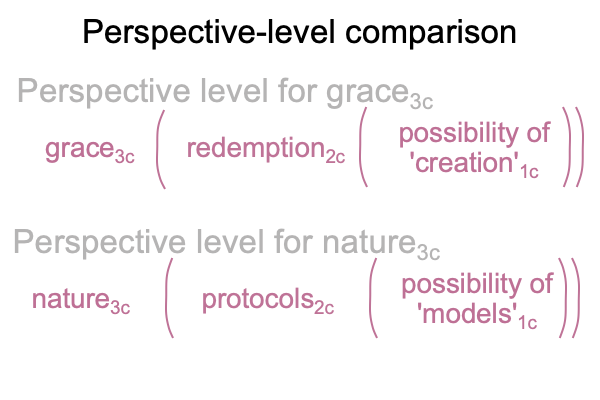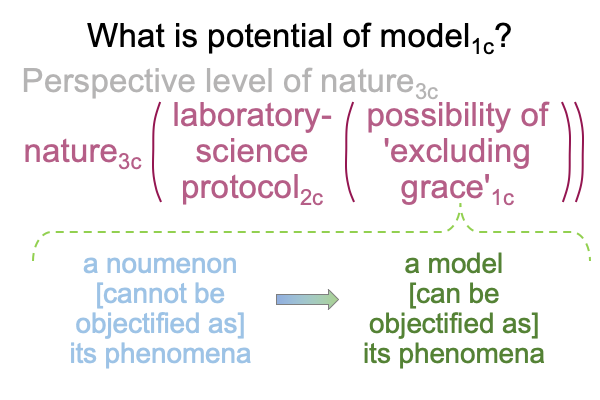0075 Once Christendom gives up on the dyadic actuality of grace [inflows] nature, then both “grace” and “nature” become distinct and separable.
Once Christendom agrees that “grace” and “nature” are distinct and separable, then that determination becomes a relation held in common by two apparently independent judgments. The relation does not belong to thirdness, the realm of normal contexts. Instead, the relation belongs to secondness, the realm of actuality.
Once the relation is assigned to the category of secondness, two parties arise. One party insists that grace3 excludes nature1, in the same way that a normal context3 may suppress a possibility1. The other party is convinced that nature3excludes grace1, in the same way that a normal context3 may rule out a possibility1.
Finally, the elevation of nature or grace entangles content, situation and perspective, resulting in the three-level “nature” and “grace” interscopes. Because each perspectivec-level normal context3 excludes the other perspectivec-level normal context3, these three-level interscopes take on lives and traditions of their own.
0076 The fact that these two parties live in the same civilization is the topic of chapter 1 of Ross’s book. This chapter is titled “Surprising Theological Developments”. Science does not seem to be hindered. Theology begins to wonder about the possibility of ‘creation’1c in the face of the apparent infallibility of ‘evolutionary models’1c.
In chapter 2, Ross considers the concept of dual revelation, calling to mind the guises of grace and nature. He asserts that nothing that scientists can discover about the world, when rightly understood, will contradict what is written in the pages of the Bible. Truth (in nature) does not contradict truth (in grace). That is a reminder of the beautiful early medieval dyad of grace [inflows] nature. But, maybe, Ross’s assertion does not go far enough to bring us back to the Middle Ages.
0077 In chapter 3, Ross isolates several articles from the Chicago Statement on Biblical Inerrancy that pertain to these two parties.
Article 19 goes like this.

0078 In chapter 4, Ross claims that disturbing concessions are being made by Christian theologians in regards to such consensus statements.
These concessions are occurring on the perspective level of grace3c.

Which possibility is more real? Creation1c or evolutionary models1c?
The inerrancy of the Bible covers the entire text, including the Creation Story and the Primeval History. But, “inerrancy” does not mean that the Bible meets the standards of “without error” for naturalism, evolutionism and scientism. “Inerrancy” means “living” as opposed to “dead”, “flawless” compared to “corrupt”, and “honest” as opposed to “deceptive”.
But, theologians are not interested in rocking the boat, so to speak. Fudging creation1c in order to support the actuality of redemption2c in the normal context of grace3c does not seem so terrible, especially when creation1c becomes more “realistic”, in the scientific sense of the word. Creation1c is expressed in myths that are consistent with the written origin stories of the ancient Near East3a.
0079 As far as the evolutionary sciences are concerned, the potential of ‘model’1c that underlies protocol2c involves elevating models1c into the place of noumena, the things themselves1c. Once, this is done, a model1c [can be objectified as] its phenomena, and protocols2c are empirio-schematic recipes that validate that each model is supported by the data.

0080 Say what?
On one hand, a noumenon (the thing itself) [cannot be objectified by] its phenomena.
On the other hand, a model taking the place of the noumenon [can be objectified as] its phenomena.
0081 So, if ‘models’1c comport with ‘excluding grace’1c by taking the place of the noumenon, then what are the consequences?
I cannot imagine that the results are well… um… honest. All the metaphysics of the Positivist’s judgment goes into the noumenon.
0082 What happens when I substitute a model for the thing itself?
Well, I lose all the metaphysical implications of what is for the Positivist’s judgment.
Even more disturbing, what if… um… the model is not the real thing?
Well, let scientists worry about that when the counterfeit becomes obvious.
Until then, the model1c must be placed into the slot for the noumenon in what is for the Positivist’s judgment, because the triumphant positivist intellect3a wills1a it1c.
Yes, to replace the noumenon (the thing itself) with a model (based on observations and measurements of phenomena) entails an act of will1a.
